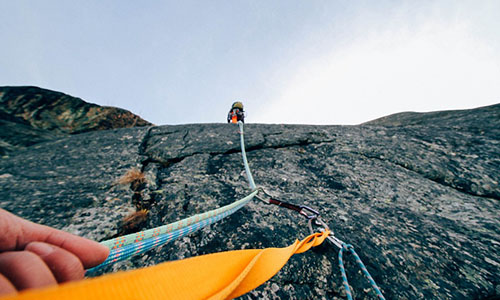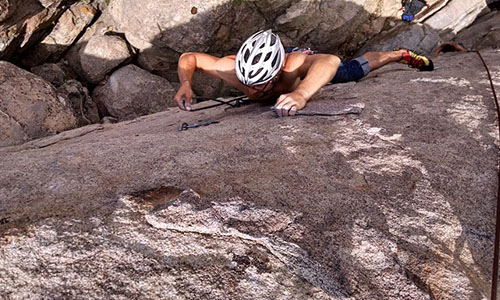A Practical Guide to Lead Climbing
Author

Chris shares his passion for cycling, hiking, skiing, and climbing from Buxton, in the Peak District. As a blogger for Outdoor Look, Chris shares outdoor tips and indoor tricks to help you get the most out of your time spent outside. When he's not out adventuring he's making videos or trying to keep up with his 4-year-old son.
 Lead climbing is one of the most intense and challenging types of climbing. If you’re lead climbing, your protection is your responsibility. There is a high possibility of falling as you climb higher. It takes you near to the ends which makes it a thrilling and time-worthy activity. You should know how to lead climb before hitting the cliffs otherwise it may be dangerous for you. In this article, you’ll learn about various forms of lead climbing and how to do it.
Lead climbing is one of the most intense and challenging types of climbing. If you’re lead climbing, your protection is your responsibility. There is a high possibility of falling as you climb higher. It takes you near to the ends which makes it a thrilling and time-worthy activity. You should know how to lead climb before hitting the cliffs otherwise it may be dangerous for you. In this article, you’ll learn about various forms of lead climbing and how to do it.
Forms of Lead Climbing:
- Trad Climbing
In trad climbing, climbers take all the protective gear like cams and wire with them for their protection. Cams are installed inside the parallel cracks. If it is installed properly, the four lobes of cam effectively bear the fall and keeps the climber safe. Wires are trapezoid-shaped gear which are fixed inside nooks or rock’s cervices.
- Sport Climbing
It is the most practised form of climbing. Climbers take a lead by stepping on the permanently fixed anchors on the rocks. They just have to carry quickdraws (two carabiners fixed to a webbing piece) for their protection. The top and bottom carabiners need to be clipped to the bolt and the rope respectively to prevent falling and also from the injuries. It is advisable to take two additional quickdraws to fix the two anchor bolts.
Practice Falling
You should know that if you fall while climbing, you will fall more than double the length of the last piece of protection.
For many climbers, climbing is all about adventure, fear control, handling the issues on the rock, and making decisions in various events. Deciding whether you must down climb, take a cigarette break, or go ahead make the rock climbing more exciting.
Climbers want to get used to the climbing and landing, this is the reason they practice falling. If you overhang a steep mountain, probably you’ll not hit any surface but fly through the air. In case, you fall on a surface, you should bend your knees and hit the surface as smoothly as possible. It is important to know about the risk of object like ledge systems, which you may hit when you fall.
Keep an Eye on the Rope behind Your Leg
 When rope is wrapped behind your leg during lead climbing, it can be dangerous for you if you fall in an inverted position. If you notice the rope behind your leg, it is advisable to slowly shift at the front to prevent yourself falling in an upside-down position.
When rope is wrapped behind your leg during lead climbing, it can be dangerous for you if you fall in an inverted position. If you notice the rope behind your leg, it is advisable to slowly shift at the front to prevent yourself falling in an upside-down position.
How to Get Down Safely?
The quickdraws need to clip into bolted anchor to get down the hill. Generally, a rope is clipped to the two bolts.
Ensure your security by clipping yourself in an anchor when climbing to the top of the cliff. Then re-thread the rope through the anchor, you can then take off the quickdraws as you get down.
Choose Easy Climbs to Start Off
You should start off easy by opting for a single pitch climb and climb with bolted anchors. Once you successfully complete one or two climbs, go for harder climbs.
You must learn to put on and off the gear as it is important for your protection on the rocks. You can join gym which offers lead climbing session where you’ll learn everything about lead climbing under a professional’s supervision.
Author

Chris shares his passion for cycling, hiking, skiing, and climbing from Buxton, in the Peak District. As a blogger for Outdoor Look, Chris shares outdoor tips and indoor tricks to help you get the most out of your time spent outside. When he's not out adventuring he's making videos or trying to keep up with his 4-year-old son.
- Speed Up Your Post-Hike Recovery with These 6 Essential Tips
- Cycling through Tranquil Roads and Coastal Views on the Isle of Wight
- The Essential Guide to Hiking Safety: 5 Tips Every Hiker Should Know
- Run Smart, Run Strong: Your Guide to Injury-Free Running
- Embrace Biking: Essential Tips for Beginners
Categories
- Sport (28)
- Product Reviews (3)
- Team Outdoor Look (7)
- Mike Wild (2)
- Mike Payton (2)
- Suse Hammond-Pears (3)
- Snowboarding (12)
- Latest Offers (105)
- Shop Talk (1)
- Competitions (7)
- Walking (413)
- Lifestyle Fashion (8)
- Travel (86)
- Kit Guides (176)
- Workwear Clothing (6)
- Safety Workwear (4)
- Health/Fitness (289)
- Skiing (91)
- Great Outdoors (1316)
- Cycling (92)
- January 2025
- December 2024
- November 2024
- October 2024
- September 2024
- August 2024
- July 2024
- June 2024
- May 2024
- April 2024
- March 2024
- February 2024
- January 2024
- December 2023
- November 2023
- October 2023
- September 2023
- August 2023
- July 2023
- June 2023
- May 2023
- April 2023
- March 2023
- February 2023
- January 2023
- December 2022
- November 2022
- October 2022
- September 2022
- August 2022
- July 2022
- June 2022
- May 2022
- April 2022
- March 2022
- February 2022
- January 2022
- December 2021
- November 2021
- October 2021
- September 2021
- August 2021
- July 2021
- June 2021
- May 2021
- April 2021
- March 2021
- February 2021
- January 2021
- December 2020
- November 2020
- October 2020
- September 2020
- August 2020
- July 2020
- June 2020
- May 2020
- April 2020
- March 2020
- February 2020
- January 2020
- December 2019
- November 2019
- October 2019
- September 2019
- August 2019
- July 2019
- June 2019
- May 2019
- April 2019
- March 2019
- February 2019
- January 2019
- December 2018
- November 2018
- October 2018
- September 2018
- August 2018
- July 2018
- June 2018
- May 2018
- April 2018
- March 2018
- February 2018
- January 2018
- December 2017
- November 2017
- October 2017
- September 2017
- August 2017
- July 2017
- June 2017
- May 2017
- April 2017
- March 2017
- February 2017
- January 2017
- December 2016
- November 2016
- October 2016
- September 2016
- August 2016
- July 2016
- June 2016
- May 2016
- April 2016
- March 2016
- February 2016
- January 2016
- December 2015
- November 2015
- October 2015
- September 2015
- August 2015
- July 2015
- June 2015
- May 2015
- April 2015
- March 2015
- February 2015
- January 2015
- December 2014
- November 2014
- October 2014
- September 2014
- August 2014
- July 2014
- June 2014
- May 2014
- April 2014
- March 2014
- February 2014
- January 2014
- December 2013
- November 2013
- October 2013
- September 2013
- August 2013
- July 2013
- June 2013
- May 2013
- April 2013
- March 2013
- February 2013
- January 2013
- December 2012
- November 2012
- October 2012
- September 2012
- August 2012
- July 2012
- June 2012
- May 2012
- April 2012
- March 2012
- February 2012
- January 2012
- December 2011
- November 2011
- October 2011
- September 2011
- August 2011
- May 2010
- April 2010
- March 2010
- February 2010
- January 2010
- November 2009
- October 2009
- September 2009
Submit a Comment